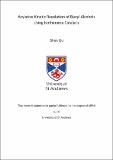Files in this item
Acylative kinetic resolution of biaryl alcohols using isothiourea catalysis
Item metadata
| dc.contributor.advisor | Smith, Andrew David | |
| dc.contributor.author | Qu, Shen | |
| dc.coverage.spatial | v, 111 p. | en_US |
| dc.date.accessioned | 2018-03-16T16:54:17Z | |
| dc.date.available | 2018-03-16T16:54:17Z | |
| dc.date.issued | 2018-06-27 | |
| dc.identifier.uri | https://hdl.handle.net/10023/12968 | |
| dc.description.abstract | This project aims to develop the first isothiourea-catalyzed acylative kinetic resolution (KR) of biaryl diols. To place this work in context, a brief introduction to chirality and its importance, an overview of methods for isolating enantiopure compounds, as well as an introduction to, and theories behind, KR is given in the Chapter 1. This chapter finishes by summarising previous publications concerning the KR of biaryl compounds and the use of isothiourea catalysts. Chapter 2 details the optimization of the model KR of (±)-BINOL, which includes screenings 3 isothiourea catalysts, 10 bench-stable solvents, 21 anhydrides as acyl donors, 3 catalyst loadings and 4 different temperatures to deliver optimal selectivity. The optimized conditions for the KR of BINOL was found to be: BTM (1 mol%); 2,2-diphenylacetic pivalic anhydride (0.55 equiv.); room temperature for 18 hours, giving high selectivity (S = 55) at 50% conversion while minimizing the formation of an unwanted diacylated side-product. The scope and limitation of this procedure were evaluated in Chapter 3, which details the synthesis and attempted KR of 13 biaryl compounds aimed to test the generality of the procedure established in Chapter 2 (Scheme 1). It was found that the selectivity of the KR is sensitive to the steric bulk and/or electronic property of the substituents on the biaryl rings. While 6/6’- and 7,7’- substitution on BINOL are well-tolerated, as well as the 4/4’, 5/5’ and 6/6’-substitution on 2,2’-biphenol, substrates bearing 3/3’-substitution could not be tolerated by this procedure. The successful KR of N-Boc-NOBIN and unsuccessful KR of mono-O-protected BINOL derivatives, suggests that two H-bond donors are required within the substrate to have good selectivity and reactivity in acylative KR. A proposed catalytic cycle, as well as a simple stereochemical model that can be used to rationalise the observed sense of asymmetric induction, is discussed in Chapter 4. | en |
| dc.language.iso | en | en_US |
| dc.publisher | University of St Andrews | |
| dc.subject | Acylation | en |
| dc.subject | Kinetic resolution | en |
| dc.subject | Isothiourea | en |
| dc.subject | Catalysis | en |
| dc.subject | Lewis base | en |
| dc.subject | Biaryl diol | en |
| dc.subject | Biaryl | en |
| dc.subject | Organocatalysis | en |
| dc.subject.lcc | QD281.A2Q8 | |
| dc.title | Acylative kinetic resolution of biaryl alcohols using isothiourea catalysis | en_US |
| dc.type | Thesis | en_US |
| dc.type.qualificationlevel | Masters | en_US |
| dc.type.qualificationname | MPhil Master of Philosophy | en_US |
| dc.publisher.institution | The University of St Andrews | en_US |
This item appears in the following Collection(s)
Items in the St Andrews Research Repository are protected by copyright, with all rights reserved, unless otherwise indicated.

